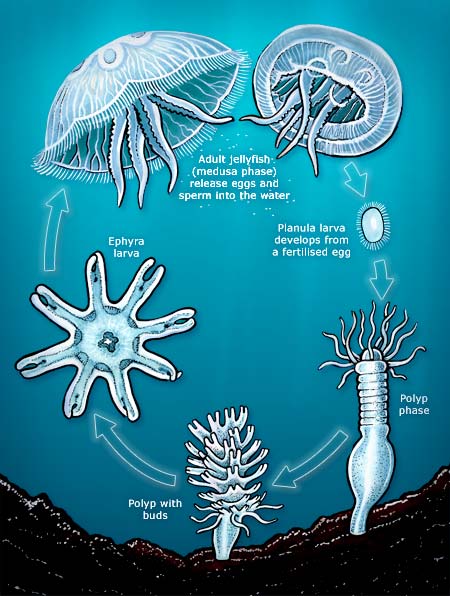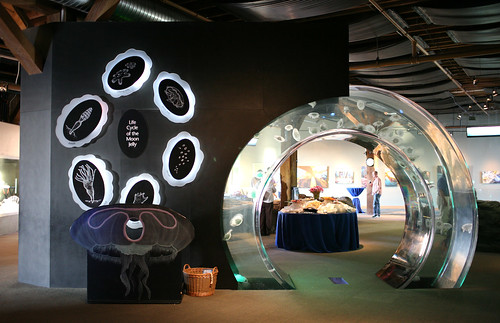While the diagram itself isn't very exciting, snippets of information relayed actually are very interesting for anyone willing top stop and pay attention. That, however, is a very rare occurrence. All volunteers are trained how to interpret this diagram, however the only time I have been able to bring up the jellyfish life cycle in conversation, was in the chemistry lab where I work. You, my lovely readers, get to be my second audience.
As the picture above displays, there are five main steps in the life cycle of jellyfish. In those five stages they reproduce both sexually AND asexually. As amazing as this sounds it isn't unique in the animal kingdom, and is fairly common among Cnidarians, the family that includes Jellies, Sea Anemones and Corals. These steps for Jellies are: 1) Larva or Egg 2) Polyp 3) Polyp with buds 4) Ephyra larve and 5) Adult or Medusa.
 1) Egg/planula
1) Egg/planulaMost Jellyfish are either male or female. When it comes time to breed they will each release their sperm or eggs respectively into the water (broadcast spawn) and hope that the egg and sperm meet and that their young are fertilized. In the moon jellies however the eggs are held in the pits of the feeding arms of the female who will take up the sperm and fertilize the eggs inside her bell. These eggs will develop into planula, a larva form covered in cilia. When large enough, these planula will leave the mother and sink into the benthos to being it's next stage of life.
2) Polyp
As the planula sink to the ocean floor they settle as a film on smooth faces such as rocks, other plankton or even fish there they develop into polyps. While at first they are just a hard round ball with only a mouth and a moderate ability to sting, they eventually develop upward facing tentacles with a mouth at the center and end up looking very much like their cousins the anemones.
3) Polyp with tufts
After a period of growth, the polyp eventually develops tufts or segments and becomes a polyp with tufts. As it continues to develop these tuffts and slowly separate in a process called budding. In some species it now begins to resemble a flower with each tuft playing the part of the petal. (Please pardon the continuing metaphor.) As the metaphorical jelly/flower matures, the petals will begin to separate from the base and fall off. Here is the amazing part that seems to come straight out of a fairytale: Each metaphoricle petal will becomes a genetically identical ephyrea and eventually A WHOLE NEW JELLY!! This is the asexual step of their reproduction.
4) Ephyrea
As the bud off these Ephyrea are the first stage in adulthood. Usually flat and radially symmetrical (like all Cnidarians and Echinoderms) they swim away from their clone/siblings to feed on plankton and eventually pulse their way towards the apex of thier lives.
5) Medusa
The Medusa is the stage of life most people think of when they imagine jellyfish. From the ephyrea stage they develop a defined bell with long feeding tentacles full of stinging cells called nematocysts trailing out below. The specific adult form changes from species to species, but it is in this form that they spend the remainder of their life pulsing around the ocean, eating what ever comes in their path. If food is plentiful enough, they will spawn daily until their inevitable last pulse.Thus completes the life cycle of the awesome jellyfish.
Jellies size, shape and life spans vary wildly around the ocean. Some smaller species live only a few days while many larger species can live a few months. Although simple, these amazing kings of plankton (for adult jellies are technically plankton) have, in my opinion, some of the most amazing and almost magical life cycles in our oceans.



No comments:
Post a Comment